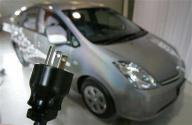2008 Detroit Auto Show: Toyota Promotes Plug-In Hybrid Development At 2008 North American International Auto Show
 |
January 14, 2008 - Detroit, MI - Toyota Motor Sales (TMS), U.S.A., Inc., today announced it will provide several Toyota Prius plug-in electric hybrid (PHEV) prototypes at the North American International Auto Show in Detroit for executive shuttle service to and from the Cobo Center.
The prototype Prius plug-in hybrids are similar to the vehicles that were recently given to two University of California campuses. These vehicles are being used for research and testing as part of Toyota's on-going sustainable mobility development program with the University of California at Irvine's Advanced Power and Energy Program and the University of California at Berkeley's Institute of Transportation Studies.
The PHEVs in Detroit, as with the vehicles at the universities, are early-development prototypes that will be used for evaluation of real-world customer use and acceptance, ride-and-drives by regulatory officials and NGOs, and technical research and development.
"Our goal with these early prototype vehicles is to begin the process of understanding customer wants and needs in order to help determine the optimal balance between electric vehicle miles, charge time, battery size and cost," said Bob Carter, Toyota Division group vice president and general manager.
A conventional gas-electric full hybrid system, such as that found in the Toyota Prius, is powered by both an electric motor and a gas engine. The system operates in pure-electric mode, pure-gas mode, or a combined gas-electric mode, depending on vehicle speed and driving conditions. The electric motor is powered by a dedicated battery pack that is kept charged by electricity generated by the gas engine and the vehicle's regenerative braking system. The fact that the hybrid battery never needs to be plugged into a recharging station has been one of the primary selling points with mainstream consumers.
The prototype plug-in hybrid system is designed to operate in a similar manner to the current Prius, switching from pure-electric mode, to gas-engine mode to a blended gas-electric mode. With the addition of a second nickel-metal hydride battery pack, the plug-in Prius can store greater levels of electricity and is charged by plugging into a standard household electrical outlet. With more electric power in reserve, the vehicle is capable of operating in pure-electric mode for longer periods of time and at much higher speeds than the current Prius. The added electrical power also produces substantial gains in fuel economy and a reduction in total tailpipe emissions versus current conventional hybrid systems.
Given its commercial success, it is no surprise that further advancement of hybrid technology is a top priority for Toyota. In May 2007, cumulative sales of Toyota hybrid vehicles worldwide topped the one million mark, a global sales target the company hopes to hit annually in the early 2010s.
In fact, by the end of calendar-year 2007, the U.S. market has accounted for nearly 750,000 combined Toyota and Lexus hybrid sales, out of the approximately 1.25 million hybrid vehicles sold globally, since the first generation Prius was introduced in Japan in 1997. Toyota estimates that the cumulative reduction in CO2 emissions by these vehicles now totals more than five million tons.


